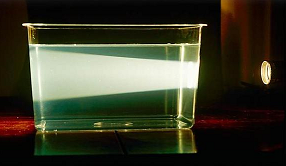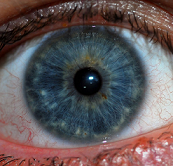There appears to be a confusion on what the Tyndall effect actually is.
In every textbook in my native language (Polish) I have read, the 'Tyndall effect' is simply a name for a cone of light that arises when light passes through a colloid. As it is said to be independent of wavelength (contrary to Rayleigh scattering) and it happens for particles of roughly similar size to the wavelengths of visible light, it seems the underlying mechanism is suggested to be Mie scattering. The same description goes for Russian, German and French Wiki.

Meanwhile, English and Spanish Wiki tells that it is actually a phenomenon akin to Rayleigh scattering (that is, shorter wavelengths are scattered more), yet it concerns particles of similar size to the wavelengths indeed. Examples given are blue irises, exhaust smoke and opalescent glass.

So what actually the Tyndall effect is? If shorter wavelenghts are scattered more (the latter approach), then wouldn't it agree well with Rayleigh scattering mechanism? If not, then how is it different from Rayleigh scattering? And if it apparently occurs for particles of diameter comparable to the wavelength (as in Mie scattering), then why is blue light scattered more?
DisclaimerEdit: I am a chemistry student with no professional knowledgeshouldn't have referred only to Wikipedia in physics; apologizemy question. My biggest concern is the discrepancy between the sources. He et al. (DOI: 10.1063/1.3068473) emphasize that Tyndall scattering arises for any inaccuracyparticles much larger than the wavelength (it is then independent of wavelength), whereas Flammer et al. in my descriptionBasic Sciences in Ophthalmology point out that Tyndall effect is indeed light scattering due to submicroscopic particles. Yet I don't see why changing particle size would give two distinct phenomena (Rayleigh's & Tyndall's) if, according to the latter approach, you get Rayleigh-like dependence.
